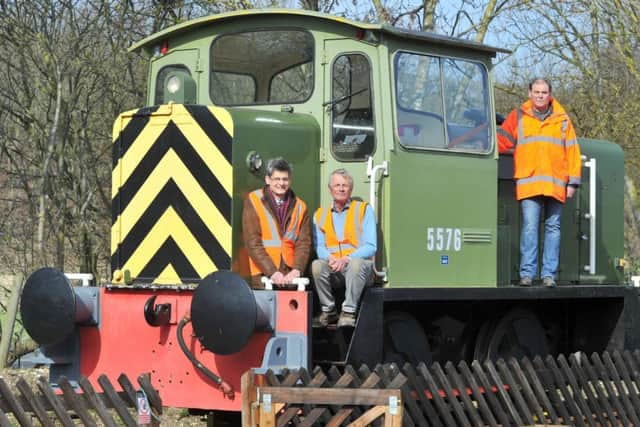Getting rail line back on track
some were closed much earlier in the 1950s as was the case with the Malton and Driffield Branch, originally the 19-mile Malton & Driffield Junction Railway, that is now being part-restored with the intention that eventually a two-mile stretch between Fimber Halt and the old Wetwang station will once again be fully active.
It’s not an easy process with track beds to be re-laid, track to be purchased and transported, logistical manoeuvres to undertake, not least of which will be in gaining approval for a level crossing, but the people behind it have the resolve and passion and thanks to a recently gained £75,000 European grant from the LEADER fund now have the impetus to add to the 150 metres of track laid since they started at the site six years ago.
Advertisement
Hide AdAdvertisement
Hide Ad“In the next two years I’d hope we will have five times the length of track we have now,” says Phil Robson of Driffield based chartered accountants Jackson Robson Licence and who counts himself a railway enthusiast.


“This was an amazing railway line cutting through wonderful Wolds countryside, but it hadn’t been built because of its scenic nature.
“It had originally been designed to carry coal from Newcastle to Hull docks through connecting up with Thirsk, via stations at Pilmoor and Gilling from Malton, and Hull via Driffield.
“Unfortunately, because it was badly financed it was made as cheaply as possible with just one nearly mile-long tunnel at Burdale, a timber viaduct at Wharram and a few bridges.
Advertisement
Hide AdAdvertisement
Hide Ad“It was meant to be double track but only one track was ever fully laid. At one end of the tunnel it was single track and at the other double track because by the time it came around to laying it at the opposite end they could only afford single track.
“It twisted around and went up and down the Wolds, which meant the bigger trains that were meant to use it never could, because it was so steep.
“One chap who used to work on steam locomotives from Dairycoates in Hull came to us on our stand at Driffield Show and told us that any of the drivers given a turn on the line would say they were ‘going over the Alps’ as it was deemed difficult to negotiate.”
Nonetheless, the Malton & Driffield branch served passenger trade for nearly 100 years before ceasing in June 1950 with freight operating until October 1958.
Advertisement
Hide AdAdvertisement
Hide AdThe line had its royal moment when King George VI arrived at Sledmere & Fimber Station where Fimber Halt is today and was a popular line for schoolchildren, grain, livestock, racehorses and carrying chalk from the quarries at Burdale and Wharram until they ceased production.
There was a massive grain warehouse owned by Laurie, Dixon & Co, corn, cake and seed merchants, located opposite where Fimber Halt is now, on what is today a popular picnic site.
“Rail was the expedient way to carry farm traffic, particularly livestock, prior to the onset of lorries and heavy haulage, with grain carried by both rail and waterways,” says historian John Lidster, whose grandfather William Dixon was station master at various stations in the East Riding including at one time Wetwang.
“Railways changed the world, slightly akin to the way the internet has today. The price of coal fell because of rail transportation, instead of coal wagons with horses, and fish and chips became our national dish because railways could move the fish from ports more quickly.
Advertisement
Hide AdAdvertisement
Hide Ad“Decades ago one of our Yorkshire Wolds Railway members, Warwick Burton, now sadly passed, wrote a book about this line and copies are available from our website. This line was in its own small way part of that history with its farming, quarrying and passenger usage.”
All of those involved with the project at Fimber Halt are enthusiastic about the progress that can now be made with the new funding, but ultimately Phil Robson believes the biggest problem the current team of around 20-25 regular volunteers faces is needing even more willing bodies.
“I’m not concerned necessarily with additional funding that may be required along the way as we lengthen the track but more that we increase our number of people involved so that we can reach the pace of growth we want to achieve.
“We need people who can give time for anything from staffing the site, manning the shop, helping out at shows where we promote the railway and all of the background work.
Advertisement
Hide AdAdvertisement
Hide Ad“You certainly don’t have to be an expert track layer or a train driver.”
Martyn Jones spent 50 years as a train guard on the North York Moors Railway before joining the ranks in 2016. He’s currently operations director responsible for looking after the diesel shunter that you can ride on, safety checks and working in the shop.
“I came here because I saw its great potential. This is currently the only heritage railway in the East Riding and this year is all set to be a very big year for all of us.
“We would love lots more people to join us as well as visit. We all love trains but our main aim as a registered charity is to return a slice of history as a visitor attraction for all the public.
Advertisement
Hide AdAdvertisement
Hide Ad“We are already doing that and increasing our numbers year on year, but now we really want to push on, lay more track, bring more engines, build the new platforms and provide something really special.”
The current cab rides are given on the 1979-built loco aptly named Sir Tatton Sykes, after the owner of Sledmere Estate, who owns much of the land where the two-mile route will be laid.
“Steam will arrive in due course,” says Phil. “We know that’s what people want to see.”